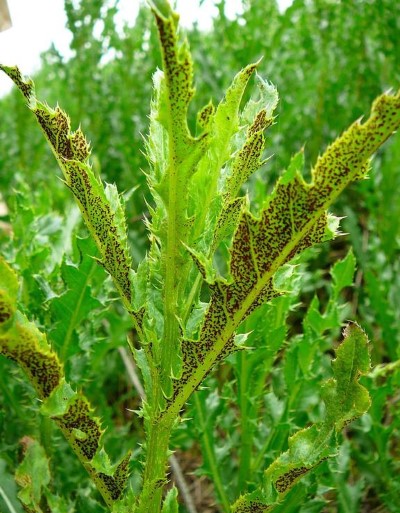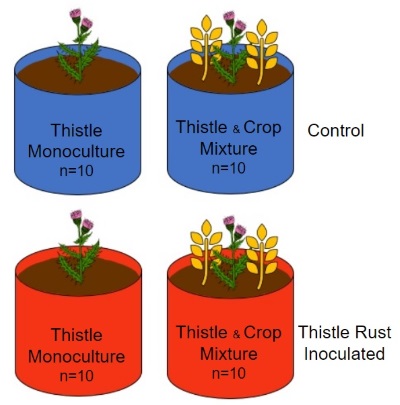Impact of thistle rust on Canada thistle performance in a simulated crop sequence
By Dan Chichinsky, Research Assistant, Montana State University
Introduction

Photo; Dan Chichinsky, MSU
Canada thistle (Cirsium arvense) is a perennial weed that causes significant economic losses in agriculture. There is a need for the development of integrated weed management toolsets that include Canada thistle biological controls. Thistle rust (Puccinia punctiformis) is a fungal pathogen that systemically infects Canada thistle, with the potential to reduce plant vigor over time (photo, right). The goal of this study was to integrate the thistle rust biocontrol with crop competition in a greenhouse environment and evaluate Canada thistle’s biomass production and competitive ability.
Methods
This greenhouse study was conducted at Montana State University between 2020 and 2022. The study consisted of three trials where Canada thistle was inoculated with thistle rust spores or treated as a non-inoculated control. Nested within the inoculated and control treatments was crop competition, split into two groups: Canada thistle grown in a monoculture and Canada thistle grown with a four-phase sequence of annual crops (figure, below right). The cropping sequence consisted of a fallow phase for Canada thistle establishment, a spring wheat phase, a pea phase, and a safflower phase. Data was collected from all pots at the time of harvest for each crop phase, where all aboveground stems were counted, and above-ground biomass was harvested. Canada thistle rhizomes were allowed to regrow, and subsequent crops were seeded directly into pots. At the end of each trial, Canada thistle rhizomes were removed from pots and weighed for final biomass analysis.

Results
The frequency of thistle rust infection in inoculated pots was 52% on average, with no infection observed in the non-inoculated (control) treatment. An average of 12% of the total Canada thistle stems produced per pot in the inoculated treatment developed signs of thistle rust infection. Above- and belowground Canada thistle biomass was lowest when thistle rust inoculation was integrated with crop competition. Average Canada thistle stem biomass was 10.38 grams per pot in the non-inoculated treatment that was grown in monoculture, and 5.60 grams per pot in the inoculated treatment that was grown with crop competition. Average root biomass was 13.88 grams per pot in the non-inoculated treatment that was grown in monoculture, and 5.57 grams per pot where thistle rust was combined with crop competition. The competitive ability of inoculated Canada thistle in the mixed treatment was reduced more than the non-inoculated thistle by the final phase in the crop sequence, relative to Canada thistle grown in the control treatment with no crop competition. It was concluded that the thistle rust pathogen can effectively reduce biomass production and competitive vigor of Canada thistle over time, showing its potential as a tool that can be integrated with crop competition.
See the entire article by Chichinsky, Larson, Eberly, Menalled, and Seipel (2023)for more details about this study.
Further Information
For more information about this month's weed post, contact Noelle Orloff. Past posts are available in the Monthly Weed Post Directory.
This weed post is also available as a printable PDF (220 KB).
